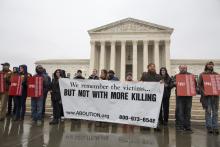public protest

WHEN I WAS 8 years old, in June 1998, three white supremacists lynched James Byrd Jr., a Black man in Jasper, Texas. After offering him a ride in their truck, they beat him, desecrated him, chained him to their vehicle, dragged him to his dismemberment and eventual death, and deposited parts of his body in front of a Black church to be found on Sunday morning. I remember hearing about the murder on the evening news and having a newly personal sense of the geography of racial terror. As a child living in California, I could not locate Jasper on a map, but its name, and Byrd’s, were forever fixed in my mind.
Earlier this year, I realized that my great-grandmother was around that same age when, in May 1918, white supremacists lynched Mary Turner and a dozen other Black people, including the baby they cut out of Turner’s abdomen. I wonder if my great-grandmother, as a child, heard the news, and how it affected her. In her case, the lynchings happened not three states but three hours from where she lived in Georgia. Unlike in Byrd’s case, there were no charges, arrests, trials, or convictions of the known and suspected murderers behind these lynchings. I wonder if and how the killings—and the impunity allowing the lynchers freedom of movement—shaped her sense of the landscape.
In Demonic Grounds: Black Women and the Cartographies of Struggle, geographer Katherine McKittrick writes that “Black matters are spatial matters.” McKittrick identifies the social production of space—how landscape is not a fixed background but is defined by relationships. Fugitivity, precarity, and possibilities of life and death are mapped realities that follow social relationships.

We resisted — and we still face the possibility of jail time, fines, and community service. Here are a few of the lessons I’ve learned planning events like this one over the years. I hope you can use them as you continue to resist unjust policies.
After months of good-faith reforms and patience, the drama is back in Egypt's Tahrir Square as protesters are preparing for a potential showdown with the state's military rule. The movement, among other things, is demanding an end to military rule -- a more radical call that reflects both the frustration with the status quo and the hope for a better way.
Two weeks ago, at the "Day of Persistence," Egypt saw its largest resurgence of public protest since former President Hosni Mubarak was ousted in February. The nation-wide protests show Egyptians camping out in Cairo's Tahrir Square, staging sit-ins and blocking traffic in Alexandria, and threatening to shut down Suez's tunnel access to Sinai. So why are the people confronting -- albeit nonviolently -- an interim government that has promised elections and a new constitution? A glance at the collective demands drafted in Tahrir Square make clear that the movement's demands -- both political and economic -- have not progressed much under the military rule of the Supreme Council of the Armed Forces.